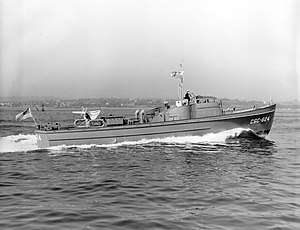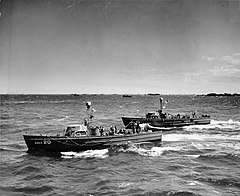83-foot patrol boat
The United States Coast Guard wooden-hulled 83-foot patrol boats (also called cutters) were all built by Wheeler Shipyard in Brooklyn, New York during World War II. The first 136 cutters were fitted with a tapered-roof Everdur silicon bronze wheelhouse but due to a growing scarcity of that metal during the war, the later units were fitted with a flat-roofed plywood wheelhouse.[4] A total of 230 83-footers were built and entered service with the Coast Guard during the war. Twelve other 83-footers were built for the Navy and were transferred to Latin American navies.[5]
 The 83-foot CGC-624 (later USCG-14) in 1942 | |
| Class overview | |
|---|---|
| Name: | 83-foot patrol boat |
| Builders: | Wheeler Shipyard, Brooklyn, New York |
| Operators: |
|
| Preceded by: | 400-series patrol boat[1] |
| Succeeded by: | Cape-class and Point-class cutters |
| Completed: | 230 |
| Preserved: | 1 |
| General characteristics [2] | |
| Class and type: | Patrol boat |
| Displacement: | 76 tons fully loaded |
| Length: | 83 ft (25 m) |
| Beam: | 16 ft (4.9 m) |
| Height: | 64 in (1,600 mm) |
| Installed power: | Twin Sterling Viking II gasoline engines[3] |
| Propulsion: | twin propellers |
| Speed: | 20 kt |
The patrol boats were powered by two 600-horsepower "Viking 2nd" Model TCG-8 inline eight-cylinder gasoline engines manufactured by the Sterling Engine Company. Their combined fuel economy was poor: 100 gallons per hour at a cruising speed of 12 knots, 120 gallons per hour at full throttle.[6]
The class was followed by Cape-class 95-foot patrol boat (or cutter) and 82-foot Point-class cutter.
Rescue Flotilla One

Sixty of the 83-foot cutters were sent to England to serve as rescue craft off each of the landing beaches during the Invasion of Normandy.[5] Officially called Rescue Flotilla One (ResFlo One), the cutters were nicknamed the "Matchbox Fleet" because their wood construction and large gasoline tanks made them potential tinderboxes.[3]
Renumbered USCG-1 through USCG-60, they were able to pull almost 500 men from the water on D-Day. The thirty cutters assigned to the American sector saved 194 men off shore from Omaha Beach and 157 near Utah Beach.[7] Arriving off the invasion beaches at 5:30 AM, the cutter USCG-16 alone rescued 126 men that day.[8] The thirty cutters assigned to the British and Canadian sectors saved 133 men from the water off Gold, Juno and Sword Beaches.[7]
No cutters were lost to enemy fire, but USCG-27 and USCG-47 foundered along the Normandy Coast during a storm on June 21, 1944.[9] Operating from June through December 1944, the cutter flotilla saved 1438 lives.[8]
Tiburon
In September, 2018, the last surviving 83-foot patrol boat, Tiburon (formerly CG-83366/USCG-11, built in 1942[10]) was purchased by a Seattle couple for $100 from another private owner who had converted it to a motor yacht. For the 75th anniversary of the Invasion of Normandy (D-Day) in June, 2019, it was on display on Lake Union near the Center for Wooden Boats and the Museum of History & Industry.[11] While moored in Seattle, Tiburon had also been the site of crew reunions for D-Day celebrations in 2006 and 2007.[12][13]
References
- Flynn 2014, p. 14.
- Flynn 2014, p. 24.
- "Matchbox 60 vital to success of Operation Neptune". Coast Guard News. Bright Mountain Media, Inc. June 6, 2015. Retrieved March 24, 2020.
- Scheina, Robert L. (1982). U.S. Coast Guard Cutters & Craft of World War II. Naval Institute Press. p. 222. ISBN 9780870217173. Retrieved March 29, 2020.
- "The U. S. Coast Guard in World War II", United States Coast Guard History Command, text accompanying photos 2002117288 and 2002120254, accessed June 10, 2019
- Acosta, Greg (March 22, 2019). "The World's Largest Inline Gasoline Engine Ever? The Sterling TCG-8". EngineLabs. Power Automedia. Retrieved March 24, 2020.
- "The U.S. Coast Guard at D-Day: Rescue Flotilla One the "Matchbox Fleet"" (PDF). U.S. Coast Guard Historian's Office. March 13, 2019. Retrieved March 28, 2020.
- "U.S. Coast Guard Rescue Flotilla One" (PDF). U.S. Coast Guard History Program. May 27, 2014. Retrieved March 24, 2020.
- "Casualties: U.S. Navy and Coast Guard Vessels Sunk or Damaged Beyond Repair during World War II 7 December 1941-1 October 1945". Naval History and Heritage Command. May 1, 2014. Retrieved March 25, 2020.
- Flynn 2014, p. 20.
- Elise Takahama (June 8, 2019). "Coast Guard cutter that survived D-Day landings being restored by King County couple". The Seattle Times.
- "June Dinner Program – Coast Guard Combat Operations on D-Day: A Local Living History Story" (PDF), PSMHS Newsletter, Puget Sound Maritime Historical Society, June 2007
- Donna Gordon Blankinship (June 6, 2006). "D-Day veteran reunited with his Coast Guard cutter 62 years after invasion". Associated Press – via Seattle Post-Intelligencer.
Sources
- Flynn, James T. Jr. (June 23, 2014), "World War II Brings 83-Footers and What Have You", U. S. Coast Guard Small Cutters and Patrol Boats 1915 – 2012: Vessel of less than 100-feet in Length (PDF), United States Department of Defense, pp. 18–30
![]()